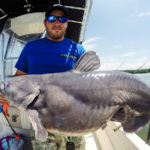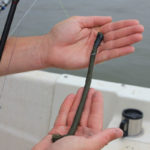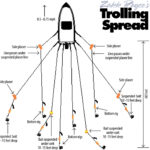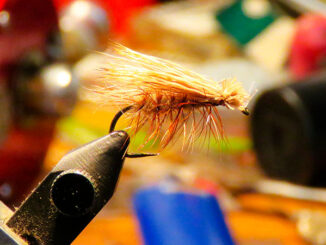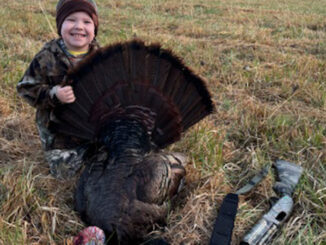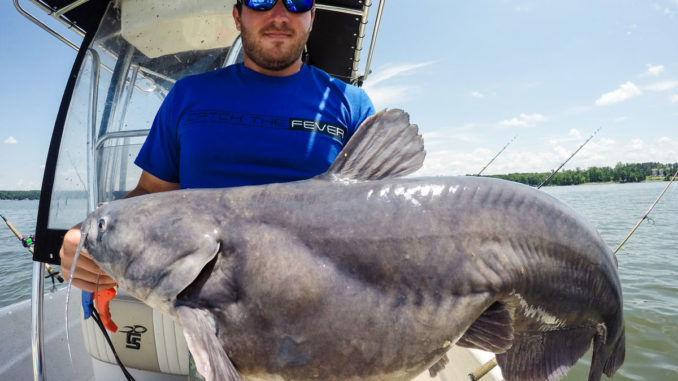
Lake Gaston on the North Carolina/Virginia border has established itself as heaven for blue catfish and the antlers who target them. The peak of summer heat presents plenty of opportunities if you know where to find them.
Zakk Royce became a household name in the fishing community this past December when he broke North Carolina’s state record for blue catfish, not once, but twice in a period of less than 24 hours at Lake Gaston — first with a 91-pound fish and then a 105-pounder he connected with soon after shuttling the first fish back to its original location to be released.
Although these fish were taken in cold weather, Royce, who runs Blues Brothers Catfish Guide Service, has a number of tricks up his sleeve when the heat is on. On a recent, hot-weather trip, he wasted no time barrelling across the lake to a set of humps resembling like a series of motocross jumps rising from a flat off the main river channel a few miles west of the Eaton’s Ferry Bridge. There, he and his father, Jon Royce, set to action, cutting fresh gizzard shad and deploying lines.
First to be splashed was a traditional setup known as a Santee rig or Carolina driftmaster rig, the most-familiar to catfishermen slow-trolling cut baits. To the 30-pound running line, he tied a three-way swivel, one ring getting a 21/2-ounce slinky weight tied on with a foot of 15-pound monofilament, and the other getting a 2-foot leader of 60-pound mono tied to a 9/0 circle hook with a 3-inch cigar float pegged between the swivel and hook.
Years ago, before the Royce’s roamed Lake Gaston in a Carolina Skiff with the latest gear, they targeted bank-fishing hotspots like the tailrace of the Roanoke Rapids Lake Dam. It was there that Zakk cut his teeth on blue catfish, and Jon came up with a great idea.
“I saw a lot of guys fishing bottom rigs for blues and stripers, and they would catch a fish here and a fish there,” Jon Royce said. “I decided to try putting my bait on a cork and fishing the current seams and eddies. We started wearing them out. People were amazed. Zakk did really great with it.”
For the Royces, that changed the stereotype of the blue catfish as a bottom-dweller into a multi-level predator. Zakk Royce took the idea of a suspended bait and morphed it into an all-out assault on the water column.
His slip-float rigs bear the same terminal tackle as his bottom- drifting rigs. However, a round, 3-inch slip float is threaded on ahead of the 3-way swivel, and the weight is trimmed to 11/2 ounces. A pair of bobber stops seize the float when the desired depth is reached and the bait rides vertically, 10 to 15 feet below the surface.
“I keep them in the rod holders that are the farthest apart in my rod rack and let one out a little farther than the other so they don’t get tangled,” Zakk Royce said. “I leave the (cigar) float between the weight and the hook, so when I go over a hump or get into shallower water, it basically turns into another bottom rig, and it doesn’t get hung up.”
Branching out a step further, two rigs are suspended on heavy-duty side-planer boards modified by a stainless steel rudder, which allows the setup to swing out further from the boat at low speeds. Running between .5 and .75 miles per hour, the planers spread between 40 and 50 feet from each side of the boat, with the rods set in the corners of the stern.
Last but not least, two more bottom rigs are cast 50 to 60 feet behind the boat. Church’s Tackle side planers are attached at the boat, and another 20 feet of line is paid out to allow the planner to run just off the stern corners.
“It’s basically a planer for walleye fishing, but it’s the only one I’ve found that you can lock down the line,” he said.
Unlike the other two planer boards, which release the line and slide down to the swivel when a fish is hooked, these remain attached. After reeling the planer to the rod, it’s quickly removed, and the fight continues.
With their dragnet assembled, the Royces stand guard, each hoping for the luck of the draw to lead a fish to his line as they split their identical offerings.
As their spread rode across a hump that rose from nearly 30 to 10 feet deep, Zakk Royce noticed the desperate flipping of shad being pushed to the surface. While the bottom rigs slid off the backside of the hump, the corks pulled their baits from the bottom. Within moments, a cork went under, a rod doubled over, and Zakk would put what he calls an average Lake Gaston catfish in the boat, weighing between 10 and 15 pounds.
From those humps, Royce moved to a nearby creek mouth, targeting the points in the mouth in the 20-foot range, and fording into the creek itself.
“People would be surprised at how shallow we catch catfish,” he said. “We’ll fish it all the way to the back, where it’s 3 feet deep. The planers work great for getting the baits under tree laps and next to docks.”
As the portside suspending planer worked into such a lap where the bank dove into a hole, it planer made a violent slash, the line broke free and the rod bent towards the water.
“This feels like a good fish,” Zakk Royce said as he leaned back to maintain pressure and then raced to collect the line as the fish swam towards the boat. Soon, another plump cat was welcomed aboard.
While the Royces say suspended baits are fruitful in most seasons, they are of particular importance in late summer when the thermocline develops.
“Simply put, the thermocline is the layer of water that has the most oxygen and the coolest water,” Zakk Royce said. “The fish can be so concentrated to that layer that you can’t even get a bite on the bottom.”
Without enough dissolved oxygen in the water on the bottom, fish are forced to suspend or relate to humps or points that rise into the thermocline and provide an ambush position.
“More of our fish come off sharp points in the late summer,” Jon Royce said, “places that give the fish some structure near the thermocline like old road beds or humps.”
Rounding such a point where the face dropped abruptly to the bottom, Jon Royce watched his cork do a vanishing act, and his rod loaded with the weight of a fish. Diving into action, he scooped up the rod and proceeded to struggle with a healthy blue that would bring the day’s total to over 20 fish.
From eating size to trophies, Lake Gaston has it all, and its accessibility from Raleigh and the Piedmont, as well as Virginia, makes it a prime target for weekenders looking to invest in one of the fastest-growing fisheries available.
DESTINATION INFORMATION
HOW TO GET THERE — Lake Gaston lies along the North Carolina-Virginia border, an hour northeast of Raleigh. I-85 crosses its westernmost reaches, and I-95 passes to the east. US 1, US 401 and US 158 are good access. The lake has an ample supply of boat ramps. Visit www.lakedirectory.net for exact locations.
WHEN TO GO — Catfishing at Lake Gaston has no offseason. Summer cats are found on the main lake, patrolling points, channel breaks and humps or flats off the main river channel. The major creeks will hold fish on similar structure, surprisingly shallow, especially when the thermocline sets up. Typical depths range from 3 to 30 feet.
BEST TECHNIQUES — Go loaded for bear, tackle-wise, with 40- to 60-pound fish common. Start with 7 to 71/2-foot Big Cat Fever rods mated to a Truth lever-drag baitcasting reel. For bottom rigs, a 30-pound monofilament tied to a 3-way swivel, from which hangs a 1½- to 2½-ounce slinky weight, and ties to a 2-foot of piece of 60-pound monofilament leader. Between a 9/0 circle hook and the swivel is a pegged, 3-inch cigar float and a bead swivel. Slip-float rigs are supported by a 3-inch round float or planer board. Two side planers also pull another pair of bottom rigs. The outfit is slow-trolled between a .5 and .75 mph. Preferred bait choices are cut gizzard shad or white perch.
FISHING INFO/GUIDES — Zakk Royce, Blues Brothers Catfish Guide Service, 252-398-7191, www.bluesbrotherscharters.com; William “Pete” Crabtree, Trophy Hunter Guide Service, 919-524-0912. See also Guides and Charters in Classifieds.
ACCOMMODATIONS — Eaton’s Ferry Motel, 252 586-7211, eatonsferrymotel.com; Lake Gaston Inn, 434- 689-2000, http://lakegastonchamber.com.
MAPS — Delorme’s North Carolina Atlas and Gazetteer, 207-846-7000, www.delorme.com; Fishing Hot Spots Maps, 800-All-Maps, www.fishinghotspots.com.

